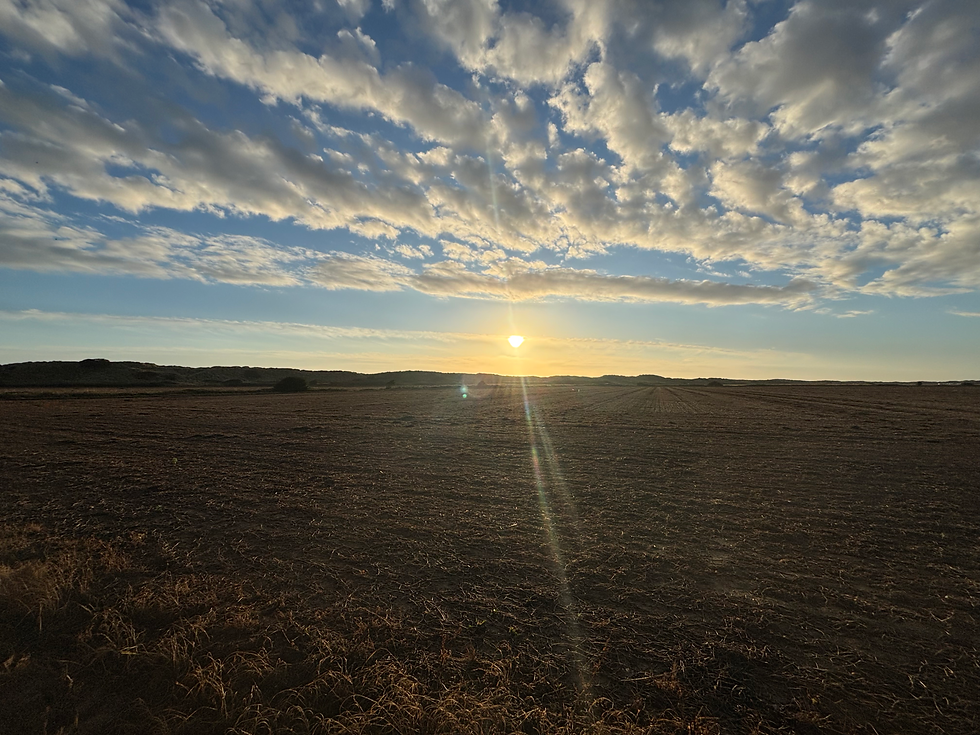Alpine Swift and a Mystery Harrier
- tg42lowcarbonbirding
- Mar 17
- 4 min read
I forgot about these at the time for some reason. Included here for completeness.

Alpine Swift, Waxham – Sea Palling Apr 14 2024
I had been out early morning with the dog as the weather was lovely and the visibility was decent but there was little moving. The only bird of note was a Grey Wagtail calling as it flew overhead. I had a break sitting in the sun and drinking a coffee before taking the bike up the track again. I hadn’t been out more than a few minutes before a call from Mick Saunt livened me up: “Alpine Swift over Horsey coming your way”. Thankfully, it wasn’t going hell-for-leather so I ought to have a decent chance with it.
I quickly made my way to the dunes and hopped onto the tops. A look to the south centred on Waxham Church showed that the lighting was a touch milky but it would be straightforward to pick out anything moving. Around 10 minutes past without anything obvious. And then another 5. However, shortly after that I got onto something that was gliding around a lot in the way that Swifts and Hirundines are wont to do. As hirundines were still thin on the ground and I hadn’t seen even one that morning, I sharpened up and got to grips with it.
From the size of the bird alone, it was clear that this was the Alpine Swift. This was also confirmed by the way it was moving. It had chosen to spend a bit of time north west of Waxham Church, somewhere in the vicinity of Henry Harvey’s large field and Lambrigg Wood. Here, it was leisurely patrolling the sky and moving in a reasonably small area rather than bolting through. As I had the bike, I decided to close the distance on the bird. These situations are where the bike comes into its own. Head down and a bit of effort for a minute saw me half the distance to the bird. I got down to the end of the path and picked the bird up easily again. Now it was possible to see the shape and structure of the bird with more clarity.
The general impression was of a large swift species, with typically long wings but with a heavier build and rear end than a Common Swift. It was also possible to see the pale underparts as the bird occasionally turned, but the hazy viewing conditions weren’t overly helpful. The flight was notably slower than that of a Common Swift with long glides and a less winnowing flight action. There’s not much else to say about an Alpine Swift other than it was a very welcome sight on another quiet morning, seemingly bereft of common migrant again. I considered cycling home and trying to see it from the house but quickly thought better of it as it started to drift north west over the north end of Brograve Level and off. I called Mick to let him know the bird had made it the short distance north and thanked him for the heads-up.
Alpine Swift are becoming more regular in east Norfolk, with a few records occurring in recent years. I think I’ve seen five now including two birds at Winterton.
Pallid Harrier or Montagu’s Harrier – Horsey, May 20 2024
It was another decent morning weather wise, and after a slow start in the village, I decided to have a cycle down to Horsey for a change of scene. There were a few bits and bobs around but little get the pulse racing. I sat in the dunes with a small group of Norfolk birders who had come over to try and see something that had been reported (can’t recall what it was, sorry!).
I didn’t have a scope so sat with my bins scanning the inland side of the coast road north of the Nelson Head track, hoping against hope for something like a Honey Buzzard, maybe. Before long I picked up a raptor coming south but distant. On initial impression I thought it looked very promising and alerted the others present to the bird. The bird was clearly a harrier and being very familiar with Marsh Harriers, seeing them pretty much every day, I certainly couldn’t see it being a Marsh.
The overall impression was of a slim, lightweight, long-tailed harrier with a flight that was airy and included a lot of banking and veering. It was possible to make out lighter underparts (particularly on the belly and undertail) and a pale underwing as the bird came a little closer. The tail was very thin, almost appearing stuck on like a lollipop stick and the rump patch was restricted, being very hard to see at times. The bird dropped and came a little closer but was still at a tricky distance. The flight was still remarkably light and bouncy, almost tern-like or reminiscent of a Long-tailed Skua. Sadly, the bird disappeared behind hedges and bushed and went through to the south, never to be seen again in east Norfolk. Of the other birders present, most failed to see the bird at all well, but one who got on it early and followed it in a scope voiced that it was very Montagu’s-like. Given the viewing distance and paucity of detail observed, I couldn’t go any further than a Pallid / Montagu’s. It did, though, look a good shout for a 2cy bird, with the brown upperparts and pale underparts and underwing.
The structure/build was much too light for a Marsh Harrier, or even a Hen Harrier, and the tail, restricted rump patch, and distinct flight manner were both very suggestive of a Pallid or a Montagu’s Harrier. It wasn’t possible to glean any more detail at the range of observation, so it will remain a Pallid / Montagu’s, very probably a 2cy.




Comments